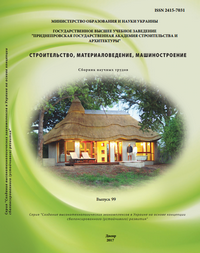Symbols of interior elements in ukrainian national house: windows, threshold, doors
Keywords:
, material and entellectual culture, national renascence, symbolism.Abstract
Abstract. The problem of the article. Housing is a prerequisite for the existence of any rights, so the material culture of each nation it has an important place. We live during the national renascence. In the history of our people there was a period when we almost lost touch with our roots and culture, but now we are striving to return to the roots. In modern Ukrainian society greatly deepened interest in the material and spiritual culture as a form of identification and identity. Our ancestors were very superstitious, so they paid much attention to various customs, rituals, etc. They were responsible for the construction and equipment of public housing. Some influence will take on the worldview of Ukrainians and can be traced now. Analysis of the sources. We find data on traditional Ukrainian housing in the researches of modern ethnographers, historians, specialists of local lore. Well-known scholars A. P. Danilyuk [1], V. P. Samoilovich [9], O. Poshivailo [7],studied the traditional architecture of the Ukrainian regions and the especially of settlements. The purpose is to analyze the symbolism of interior elements in the Ukrainian folk dwelling, in particular windows, thresholds, doors; disseminate knowledge about the cultural heritage of Ukraine. Conclusion. Over time, much has changed, but the love of Ukrainians to their home has remained unchanged. Today, like a hundred years ago, ordinary peasant houses are full of various household products that carry a double meaning. They can serve not only ordinary household items, but also have a hidden symbolic meaning. All these objects are intertwined at the energy level and form a kind of personal peace within your home. Thus, a harmonious space is formed in which our ancestors lived, and now we live - modern Ukrainians. That is why it is important for us to understand not only how the image of traditional Ukrainian housing has changed, but what it was originally. After all, before the usual window or door was given a hidden meaning and acted as wards or mysterious portals for our ancestors. In turn, we must not only know all these beliefs, but also preserve and pass on to their descendants in order to preserve the traditions and cultural heritage of our people.References
Danylyuk A. G. Ukrainska hata / A. G. Danylyuk. – K. : Naukova dumka, 1991. – 110p.
Vakulyk I.I., Puzyrenko Y.V. Kulʹtura dilovoho i simeynoho spilkuvannya: interaktyvni vpravy, zavdannya, testy: Navchalʹnyy posibnyk [Culture of business and family communication:interectiv exercises,assignments, tests:Tutorial]. — Kyiv: Center of information technology, 2007, — 150 p.
Vakulyk I.I., Puzyrenko Y.V. Ukrayinoznavstvo: Metodychnyy posibnyk dlya studentiv pedahohichnoho fakulʹtetiv [Ukrainian Studies: Methodological manual for students of pedagogical faculties]. — Kyiv: NUBiP,2010.(in Ukrainian), — 199 p.
Yevsyeyeva H.P., Yehorova V.S. Sakralʹni osoblyvosti interʺyeru ta ozdoblennya ukrayinsʹkoyi khaty // Istoriya ta tradytsiyi ukrayinsʹkoho narodnoho zhytla Prydniprovsʹkoho rehionu [Sacred interior features and trim of houses // Ukrainian history and traditions of Ukrainian folk dwelling Dnipro region]. — Dnepropetrovsk: PDABA,2016. —269 p. — P. 117-153.
Zdoroveha N.I. Narysy narodnoyi obryadovosti na Ukrayini [Featuresof folk rituals in Ukraine]. — Kyiv, 1997, — 84 p.
Marko Vovchok, Markovych O. Folʹklorni zapysy [Folk entries]. — Kyiv, 1983 — 527 p.
Ponshvaylo O. Etnohrafiya ukrayinsʹkoho sela [Ethnography of Ukrainian village]. — Kyiv, 1993, — 476 p.
Ponomariv A.P., Artyukh L.F., Kosmina T.V. and etc. Ukrayinsʹka mynuvshyna: Ilyustrovanyy etnohrafichnyy dovidnyk [Ukrainian past: Ethnographic Illustrated dictonary]. — Kyiv: Lybid, 1993., P.87-95.
Samoylovych V. P. Ukrainske narodne zytlo (kinec XIX – pochatok XX st.) / V. P. Samoylovych. – K. : Naukova dumka, 1972. – 56 p.
Downloads
Published
Issue
Section
License
Редакція Видання категорично засуджує прояви плагіату в статтях та вживає всіх можливих заходів для його недопущення. Плагіат розглядається як форма порушення авторських прав і наукової етики.
При виявлені у статті більш ніж 25% запозиченого тексту без відповідних посилань та використання лапок, стаття кваліфікується як така, що містить плагіат. У цьому випадку стаття більше не розглядається редакцією, а автор отримує перше попередження.
Автори, в статтях яких повторно виявлено плагіат, не зможуть публікуватися в усіх журналах Видавництва ДВНЗ «Придніпровська державна академія будівництва та архітектури».
Автори, які публікуються у цьому журналі, погоджуються з наступними умовами:
- Автори залишають за собою право на авторство своєї роботи та передають журналу право першої публікації цієї роботи на умовах ліцензії Creative Commons Attribution License, котра дозволяє іншим особам вільно розповсюджувати опубліковану роботу з обов'язковим посиланням на авторів оригінальної роботи та першу публікацію роботи у цьому журналі.
- Автори мають право укладати самостійні додаткові угоди щодо неексклюзивного розповсюдження роботи у тому вигляді, в якому вона була опублікована цим журналом (наприклад, розміщувати роботу в електронному сховищі установи або публікувати у складі монографії), за умови збереження посилання на першу публікацію роботи у цьому журналі.
- Політика журналу дозволяє і заохочує розміщення авторами в мережі Інтернет (наприклад, у сховищах установ або на особистих веб-сайтах) рукопису роботи, як до подання цього рукопису до редакції, так і під час його редакційного опрацювання, оскільки це сприяє виникненню продуктивної наукової дискусії та позитивно позначається на оперативності та динаміці цитування опублікованої роботи (див. The Effect of Open Access).

